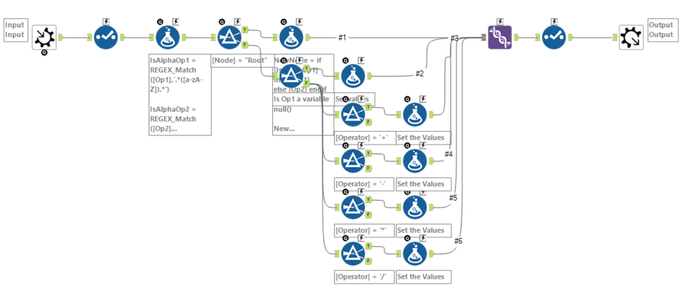General Discussions
Discuss any topics that are not product-specific here.- Community
- :
- Community
- :
- Participate
- :
- Discussions
- :
- General
- :
- Re: Advent of Code 2022 Day 21 (BaseA Style)
Advent of Code 2022 Day 21 (BaseA Style)
- Subscribe to RSS Feed
- Mark Topic as New
- Mark Topic as Read
- Float this Topic for Current User
- Bookmark
- Subscribe
- Mute
- Printer Friendly Page
- Mark as New
- Bookmark
- Subscribe
- Mute
- Subscribe to RSS Feed
- Permalink
- Notify Moderator
- Mark as New
- Bookmark
- Subscribe
- Mute
- Subscribe to RSS Feed
- Permalink
- Notify Moderator
P1 not so bad. I tried to brute force P2 but figured i'd guess and check numbers one at a time to find the relationship between values
P2 was doing a replace on humn's value by hardcoding some numbers into an adjusted macro to spit out the results. I wrote down input/output and figured out a relationship then kept manually replacing til I got it. Took about 30 minutes of trial/error



- Mark as New
- Bookmark
- Subscribe
- Mute
- Subscribe to RSS Feed
- Permalink
- Notify Moderator
Day 21 done! Really enjoyed today. Working back from the root and building out the solver was very fun!

Macro 1 - LookupBuilder - Iterates through expressions to work out all numbers:

Macro 2 - DependencyTree - Works back from the route to find all numbers that depend on humn:

Macro 3 - HumnSolver - Iterates backwards from the root, solving for humn:

Get the impression this was super overkill but hey ho - good macro practice!
- Mark as New
- Bookmark
- Subscribe
- Mute
- Subscribe to RSS Feed
- Permalink
- Notify Moderator
In the first challenge, I tried to clear it by brute force, but could not.
When I reconsidered, I was able to create a concise logic.

Macro for Part1: Replace Macro

Part2: Replace Macro for Part 2: The condition for macro ending is different from part 1 macro.

Part2 : Reverse analysis Macro
The left and right sides are interchanged for analysis.

- Mark as New
- Bookmark
- Subscribe
- Mute
- Subscribe to RSS Feed
- Permalink
- Notify Moderator
Guess and Check for part2
- Mark as New
- Bookmark
- Subscribe
- Mute
- Subscribe to RSS Feed
- Permalink
- Notify Moderator
Full workflow solutions here: https://github.com/clmc9601/Advent-of-Code-solutions/tree/main/2022%20Alteryx
 workflow
workflow iterative macro
iterative macro- Mark as New
- Bookmark
- Subscribe
- Mute
- Subscribe to RSS Feed
- Permalink
- Notify Moderator

workflow
Part1:
split to data with number and equation.
build a macro to replace to equation, if the equation is solvable, add to iteration until everything solved!

part1 macro
Part2:
using method learn from neural network. add the error to the number with certain percentage.
e.g. question is: find b, when 1000 - b = 100, rate is 10%
round 1: guess b = 300, then error is 600, multiply by rate, then add 60 (600*10%) to b
round 2 will be b = 360 (300+60), then error now will be 540, multiply by rate, then add 54 (540*10%) to b
etc.
the b will slowly close to correct amount.
key is the rate can't too high as we do not know what calculation taking place.

part2 macro
- Mark as New
- Bookmark
- Subscribe
- Mute
- Subscribe to RSS Feed
- Permalink
- Notify Moderator
:-) well over a month late and Day 21 is done.
I really liked this one - a bit of tree-logic, a bit of dynamic execution, a bit of "solve for X" - what's not to love :-)
1) Parse: get it into a flat data structure - I chose to go with a flat table with NodeName; Operand1; Operand 2; and the Operator.
2) Resolve: This is kinda like a variable resolution process in compiler theory - you take the list of nodes and break them in to 2 groups
- Where we still have variables to replace with real values
- where we have an actual value (a literal)
Then you just loop, replacing variables with literal values until you run out - and that solves part 1
3) the solve-for-x
Part 2 is kinda interesting
if you have a massive binary tree - where buried somewhere in the tree is a value that you don't know - then you do get something else for free:
- One half of the tree will completely resolve to a literal number.
- The half with the unknown value (humn) will flatten out to a simple chain of linked formulae - because anything that doesn't have the humn in it's direct parentage will just resolve to a literal number
So to do part 2:
- Remove the Human node from the set (which had a literal value in the original)
- Run part 1 - then you get a chain of one side of the tree that still needs to be resolved - all simple formulae with one known value and one unknown value
- Do a "Solve for X". for example - if you have a situation where XX = ?? + YY - then you can convert this to solve for ?? by saying that ?? = XX - YY.
- this essentially turns the chain that was left inside-out so that humn becomes the root
- Then just run your Part 1 solver again

The Tree Solver:

The Solve for X:

-
.Next
1 -
2020.4
1 -
AAH
3 -
AAH Welcome
8 -
ABB
1 -
Academy
222 -
ADAPT
9 -
ADAPT Program
1 -
Admin
1 -
Administration
2 -
Advent of Code
134 -
AHH
1 -
ALTER.NEXT
1 -
Alteryx Editions
4 -
Alteryx Practice
441 -
Analytic Apps
6 -
Analytic Hub
2 -
Analytics Hub
4 -
Analyzer
1 -
Announcement
73 -
Announcements
25 -
API
3 -
App Builder
9 -
Apps
1 -
Authentication
3 -
Automation
1 -
Automotive
1 -
Banking
1 -
Basic Creator
5 -
Best Practices
3 -
BI + Analytics + Data Science
1 -
Bugs & Issues
1 -
Calgary
1 -
CASS
1 -
CData
1 -
Certification
270 -
Chained App
2 -
Clients
3 -
Common Use Cases
3 -
Community
812 -
Computer Vision
1 -
Configuration
1 -
Connect
1 -
Connecting
1 -
Content Management
4 -
Contest
46 -
Contests
1 -
Conversation Starter
159 -
COVID-19
15 -
Data
1 -
Data Analyse
2 -
Data Analyst
1 -
Data Challenge
185 -
Data Connection
1 -
Data Investigation
1 -
Data Science
102 -
Database Connection
1 -
Database Connections
3 -
Datasets
3 -
Date type
1 -
Designer
1 -
Designer Integration
4 -
Developer
5 -
Developer Tools
2 -
Directory
1 -
Documentation
1 -
Download
3 -
download tool
1 -
Dynamic Input
1 -
Dynamic Processing
1 -
dynamically create tables for input files
1 -
Email
2 -
employment
1 -
employment opportunites
1 -
Engine
1 -
Enhancement
1 -
Enhancements
2 -
Enterprise (Edition)
2 -
Error Messages
3 -
Event
1 -
Events
107 -
Excel
1 -
Feedback
2 -
File Browse
1 -
Financial Services
1 -
Full Creator
2 -
Fun
153 -
Gallery
2 -
General
23 -
General Suggestion
1 -
Guidelines
13 -
Help
72 -
hub
2 -
hub upgrade 2021.1
1 -
Input
1 -
Install
2 -
Installation
4 -
interactive charts
1 -
Introduction
25 -
jobs
2 -
Licensing
3 -
Machine Learning
2 -
Macros
3 -
Make app private
1 -
Marketplace
8 -
Maveryx Chatter
12 -
meeting
1 -
migrate data
1 -
Networking
1 -
New comer
1 -
New user
1 -
News
26 -
ODBC
1 -
Off-Topic
124 -
Online demo
1 -
Output
2 -
PowerBi
1 -
Predictive Analysis
1 -
Preparation
3 -
Product Feedback
1 -
Professional (Edition)
1 -
Project Euler
18 -
Public Gallery
1 -
Question
1 -
queued
1 -
R
1 -
Reporting
1 -
reporting tools
1 -
Requirements
1 -
Resource
117 -
resume
1 -
Run Workflows
10 -
Salesforce
1 -
Santalytics
9 -
Schedule Workflows
6 -
Search Feedback
76 -
Server
2 -
Settings
2 -
Setup & Configuration
5 -
Sharepoint
2 -
Starter (Edition)
1 -
survey
1 -
System Administration
4 -
Tax & Audit
1 -
text translator
1 -
Thursday Thought
57 -
Tips and Tricks
6 -
Tips on how to study for the core certification exam
1 -
Topic of Interest
167 -
Udacity
2 -
User Interface
2 -
User Management
5 -
Workflow
4 -
Workflows
1
- « Previous
- Next »


